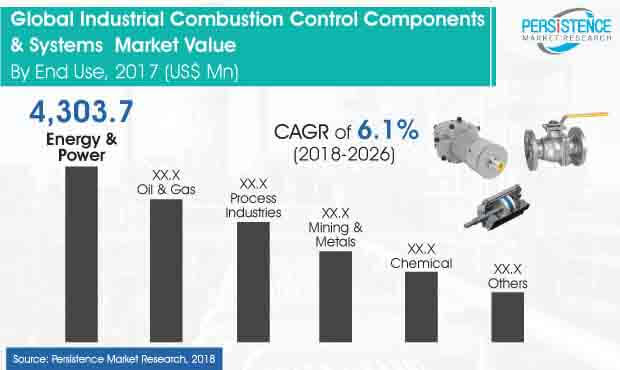Industrial Combustion Control Components and Systems Market Segmented By Valves, Actuators, Sensors, Control Motors, Combustion Enclosures, Flow Meters as Components and Emission Monitoring Systems, Emission Control Systems with Boilers, Incinerator, Dryers, Thermal Oxidizers, Gas Turbines Application
Industry: Industrial Automation
Published Date: April-2018
Format: PPT*, PDF, EXCEL
Delivery Timelines: Contact Sales
Number of Pages: 331
Report ID: PMRREP22753
As per the data provided by the United States Energy Information Administration, in 2018, the population of the world was 7.6 billion and the power consumption is estimated to increase by 48 percent between 2012 and 2040.
Most of this growth is concentrated in the Asian countries, Europe and Middle East and Africa. Due to this ever-increasing worldwide energy demand, the demand for thermal plants will be significantly increased. This in turn, will drive the market of industrial combustion control systems and components.
Due to the adverse effects of climate change, the governments across the world have been forced to enact strict regulations on the emissions of sulfur oxides, nitrogen oxide and particulate matters.
Paris agreement by UNFCC, EPA guidelines by the United States government for waste water management, new emission standards by the government of China to restrict the emission of VOCs (volatile organic compounds) in the country are some examples of such stringent regulations. These type of new regulations will also contribute to the growth of the industrial combustion control components and systems market.
Energy and power is a commodity for every industry and its demand is expected to witness steady growth in the Americas in the coming years. However, with increasing concerns pertaining to harmful particulates emitted by industries, such as chemicals, energy and power and oil & gas, the region is predominantly focusing on cutting down on emissions by adopting combusting control systems in the combustion systems of boilers, thermal oxidizers, etc.
In order to reduce emissions, United States has framed and implemented stringent governmental regulations. In June 2017, the United States entered the Paris Agreement within UNFCC (United Nations Framework Convention on Climate Change) with other countries to reduce the emission of volatile organic gases.
Under this agreement, the U.S. will be expending efforts to curb the global temperature rise during this century to below 20 C. This development is going to have a positive impact on the industrial combustion control components and systems market during the period of assessment.
The lack of resources and technological awareness could hinder consumer transition from simple industrial combustion control components to the state of art industrial combustion control systems. In addition, control systems require frequent maintenance, such as replacement of components.
This could be unfavorable for the growth of industrial combustion control components and systems market as consumers would not prefer to upgrade their industrial combustion control components regularly.

In terms of value, the chemical segment was valued at US$ 1,786.9 Mn by 2017 end. This segment is estimated to display a CAGR of 4.5% and reach a value of US$ 2,638.9 Mn by the end of 2026. The mining and metal segment is expected to reach US$ 3,549.6 Mn in 2026 from US$ 2,111.9 Mn in 2017.
The segment is estimated to exhibit a CAGR of 6.0% during the forecast period. The process industry segment was valued at US$ 2,932.3 Mn by 2017 end. This segment is estimated to exhibit a CAGR of 5.4% and reach a value of US$ 4,663.3 Mn by the end of 2026.
| Attribute | Details |
|---|---|
| Product |
|
| End Use |
|
| Application |
|
| Region |
|
To know more about delivery timeline for this report Contact Sales
